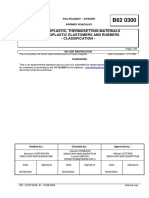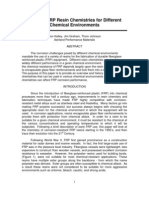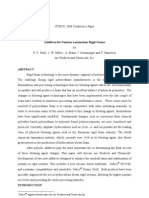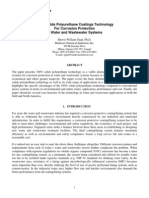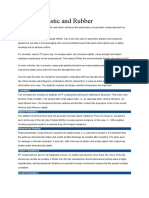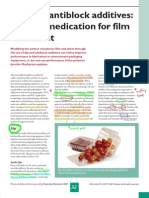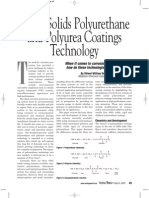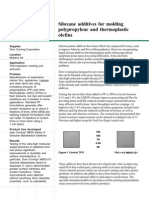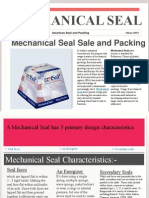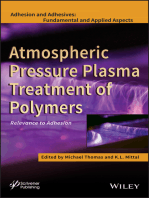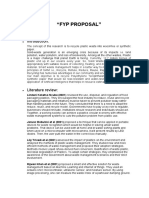Busan 11-M1 Uses
Busan 11-M1 Uses
Uploaded by
Jinson KurianCopyright:
Available Formats
Busan 11-M1 Uses
Busan 11-M1 Uses
Uploaded by
Jinson KurianCopyright
Available Formats
Share this document
Did you find this document useful?
Is this content inappropriate?
Copyright:
Available Formats
Busan 11-M1 Uses
Busan 11-M1 Uses
Uploaded by
Jinson KurianCopyright:
Available Formats
Successful uses of Buckman products in plastic and rubber compounds
Busan 11-M1 has found its greatest success in the area of flexible polyvinyl chloride compounds as a fire retardant, mold inhibitor, and UV light stabilizer. The areas in which the product should be promoted are automotive exterior applications (vinyl tops and trim), inflatable buildings, pond liners, roofing materials, canvas, tarpaulins, and awnings. Interior applications are shower curtains, wall coverings, and furniture coverings. Busan 11-M1 can be promoted as a 100% replacement for antimony trioxide in some applications; however, we have been most successful in areas as a 50% replacement for the antimony in the compound. Also, best results are achieved in conjunction with a halogen donor, such as chlorinated paraffin. The bromine type of halogen donors is perhaps the most effective with Busan 11-M1. Care should be taken in recommending Busan 11-M1 in highly plasticized products. We have found it effective in plastic compounds containing 40 parts of plasticizer per 100 parts resin or less. In plastic compounds containing more than 40 parts plasticizer, Busan 11-M1 does not appear to be as effective as antimony trioxide. In addition to use as a fire retardant, the mold inhibiting characteristics of Busan 11-M1 should be emphasized. Success with Busan 11-M1 has been obtained in the plasticized flexible polyvinyl chlorides. Our competition in this area would come from such products as the Vinyzene BP5 from Morton International and the Microcheck products from Ferro. In some applications, customers report success with a combination of Busan 11-M1 and either the Vinyzene or Microcheck products. The purpose of this combination is to add the leachable products, such as Vinyzene, to give the initial protection in the petri dish test and the Busan 11-M1 for long-term protection. If a compound calls for five-or-six parts per 100 parts resin of a fungicide, the larger fraction should be the Busan 11-M1. In the mold inhibiting area, the most success has been realized with the flexible products with only mild success in the rigid PVC compounds. Another strong competitor in the plastics industry is alumina trihydrate. In this area, we cannot compete due to the low cost of the alumina trihydrates. Also, another strong competitor will be zinc borate products. In many applications, the water of hydration is given up more easily with both the zinc borate and the alumina trihydrates than with Busan 11-M1. The one mole of water in Busan 11-M1 tends to be more completely tied up and less easily extractable. In areas where we come up against zinc borate or alumina trihydrate, the multifunctionality of Busan 11-M1 should be promoted, that being the fire retardancy, the mold inhibition, and the UV light stabilization. While successful in many plastics applications, there are some areas in which Busan 11-M1 has not been found to be effective, especially as a fire retardant. Some of these are engineered plastics, polyesters, polyolefins, and the styrenes (generally). In polyesters, you will probably find the use of alumina trihydrates as fillers for fire retardant applications. Also, many of the manufacturers of polyester parts use other mineral fillers, such as calcium carbonate. Many of the polyester compounds have already incorporated some type of fire-resistant additive. Also, in the other problem areas, those being the engineered plastics (nylon, fluorocarbons, polycarbonates), the styrenes (ABS and SAN), and the polyolefins, antimony has proven to be more effective than Busan 11-M1. Several trials have been conducted in the engineered plastics area with little success having been gained to date. It was discovered that Busan 11-M1 is a very effective replacement for antinomy trioxide in epoxy compounds. In this case, a direct one-for-one replacement proves to be very successful.
Please see important information on reverse side.
1994 Buckman Laboratories, Inc. All rights reserved. Printed in U.S.A.
CREATIVITY FOR OUR CUSTOMERS
Internal use only B85W (6/98)
For rubber applications, Busan 11-M1 has been most effective in the area of industrial rubber products, such as conveyor belts and hoses, in meeting the U.S. Bureau of Mines specifications. Most of these rubber products are SBR types. We have received reports that no difference could be detected between Busan 11-M1 and antimony trioxide in these industrial products. Busperse 47 has also found its use in the area of plastics, especially with polyesters. Busperse 47 is an excellent dispersant and wetting aid for those resins that are hard to wet out. One of our greatest success stories concerning Busperse 47 is in the area of an FR polyester application. The customer was making a fire retardant air conditioner housing for recreational vehicles. By adding 57 parts Busperse 47, the customer was able to reduce the viscosity, thus additional alumina trihydrate was added to give better FR properties and also lower their compound cost. Also, it was
discovered in this compound that better impact resistance and dimensional stability were achieved. The strength and dimensional stability can be related to the fact that Busperse 47 is probably wetting out the fiberglass causing better adherence of the polyester to glass fibers. Recent market surveys show that the plastics industry is growing at a faster rate than many of the other industries included in the studies. Therefore, plastics provide Buckman an opportunity for additional growth with Busperse 47 and Busan 11-M1. It should be emphasized that in most of these areas the compounders of the plastics and rubber compounds will be the people to contact and not the molders or extruders. Many times the molders and extruders specify products to be added to their compounds before they are purchased. Therefore, we must deal with the compounders of the plastics and rubber compounds.
You might also like
- Polyurethane (PU) : HistoryDocument28 pagesPolyurethane (PU) : HistoryPrithviraj Daga83% (12)
- FRP Piping Design Manual - Sep-06Document27 pagesFRP Piping Design Manual - Sep-06Sabir Nasim100% (3)
- Great Lakes Polymer - StabilisersDocument16 pagesGreat Lakes Polymer - StabilisersRubber Team100% (1)
- B62 0300 (Rev. B 2004.08) EN - THERMOPLASTIC, THERMOSETTING MATERIALS THERMOPLASTIC ELASTOMERS AND RUBBERS - CLASSIFICATIONDocument20 pagesB62 0300 (Rev. B 2004.08) EN - THERMOPLASTIC, THERMOSETTING MATERIALS THERMOPLASTIC ELASTOMERS AND RUBBERS - CLASSIFICATIONDiego CamargoNo ratings yet
- PVH - Restricted Substance ListDocument31 pagesPVH - Restricted Substance ListDebashishDolonNo ratings yet
- FRP Vs Rotomolded Plastic TanksDocument3 pagesFRP Vs Rotomolded Plastic TanksKimberly Conley0% (1)
- Space Fire-Safe Polymers Are: PolymerDocument4 pagesSpace Fire-Safe Polymers Are: PolymerRajat GuptaNo ratings yet
- Fluoropolymers Coatings - Extreme PerformanceDocument5 pagesFluoropolymers Coatings - Extreme PerformanceAnselmo RibeiroNo ratings yet
- Environmental Benefits of GRPDocument2 pagesEnvironmental Benefits of GRPIzo SeremNo ratings yet
- FRP Ashland - Different FRP Resin Chemistries For Different Chemical EnvironmentsDocument6 pagesFRP Ashland - Different FRP Resin Chemistries For Different Chemical EnvironmentsHafiz Kamal100% (1)
- UTECH 2000, Additives For Pentane Lamination Rigid FoamsDocument12 pagesUTECH 2000, Additives For Pentane Lamination Rigid Foamszhangp6No ratings yet
- 100% Solids Polyurethane Coatings Technology For Corrosion Protection in Water and Wastewater SystemsDocument0 pages100% Solids Polyurethane Coatings Technology For Corrosion Protection in Water and Wastewater SystemsAkbar KamalNo ratings yet
- Thermoplastic Carbonate Groups ToughDocument3 pagesThermoplastic Carbonate Groups ToughAnish KumarNo ratings yet
- Lanxess Butyl BrochureDocument12 pagesLanxess Butyl Brochureroman663No ratings yet
- Talc For Plastic and RubberDocument2 pagesTalc For Plastic and Rubberfcchemicalsupply CompanyNo ratings yet
- Formulating For Extruding AbateDocument11 pagesFormulating For Extruding Abatehossny100% (1)
- ข่าว1 pdf-notes flattened 201307151439Document4 pagesข่าว1 pdf-notes flattened 201307151439khala1391@gmail.comNo ratings yet
- FFX Technical White Paper The Future of WA Technology 210601Document11 pagesFFX Technical White Paper The Future of WA Technology 210601Nelly DavedNo ratings yet
- Flame and Smoke in Vinyl Chloride Polymers  " Commercial Usage and Current DevelopmentsDocument25 pagesFlame and Smoke in Vinyl Chloride Polymers  " Commercial Usage and Current Developmentsabilio_j_vieiraNo ratings yet
- 5-MS00063645 Polyisocyanates Prepolymers SF05 0313 MADocument40 pages5-MS00063645 Polyisocyanates Prepolymers SF05 0313 MAHugo Wizenberg100% (1)
- 100 % Solid Polyurea PDFDocument0 pages100 % Solid Polyurea PDFA MahmoodNo ratings yet
- 2006 - Fiberglass Reinforced Plastic Institute FRP 101 and Laminate CertificationDocument12 pages2006 - Fiberglass Reinforced Plastic Institute FRP 101 and Laminate CertificationingnatatlNo ratings yet
- Coaker (2003) - Journal - Fire and Flame Retardants For PVC. Journal of Vinyl and Additive TechnologyDocument8 pagesCoaker (2003) - Journal - Fire and Flame Retardants For PVC. Journal of Vinyl and Additive TechnologyBrandon BroNo ratings yet
- Advantages and Limitations of FRPDocument4 pagesAdvantages and Limitations of FRPWolfMensch1216No ratings yet
- Polypropylene: Related StoriesDocument6 pagesPolypropylene: Related Storiesalagiri sundaramoorthyNo ratings yet
- 26 069 01Document2 pages26 069 01Aakash SharmaNo ratings yet
- AYA Allah Mahmoud - 5632 PolyDocument11 pagesAYA Allah Mahmoud - 5632 Polyaya mahmoudNo ratings yet
- 05 - Chapter 1Document23 pages05 - Chapter 1Tube10 rNo ratings yet
- Engineering PolymersDocument18 pagesEngineering PolymersUmer FarooqNo ratings yet
- Chapter 9 Polymeric Materials From Petroleum ModDocument21 pagesChapter 9 Polymeric Materials From Petroleum ModAbdurabu AL-MontaserNo ratings yet
- Tech Coating SelectionDocument8 pagesTech Coating SelectionKarthikeyan Shanmugavel100% (1)
- Chap12 PDFDocument44 pagesChap12 PDFYassine OuakkiNo ratings yet
- Journal Pre-Proof: Polymer TestingDocument42 pagesJournal Pre-Proof: Polymer TestingEkansh ChoudharyNo ratings yet
- Tolinski2009 19Document9 pagesTolinski2009 19noorollahmirzaeyanNo ratings yet
- PVC's Physical Properties - PVCDocument8 pagesPVC's Physical Properties - PVCalguzduxtanNo ratings yet
- Mechanical SealsDocument3 pagesMechanical SealsMechanical Seal and PackingNo ratings yet
- Polyisocyanurate vs. Polyurethane InsulationDocument2 pagesPolyisocyanurate vs. Polyurethane Insulationhamza awanNo ratings yet
- XPU Flooring Balcony Case StudyDocument12 pagesXPU Flooring Balcony Case Studyyasafy100% (1)
- K 2007 Additives ReviewDocument7 pagesK 2007 Additives ReviewNguyen Xuan Giang0% (1)
- Application of PolymersDocument22 pagesApplication of PolymersJaveed AkhtarNo ratings yet
- General Polyurea Questions (Versaflex)Document6 pagesGeneral Polyurea Questions (Versaflex)thinesNo ratings yet
- Automobile ProjectDocument21 pagesAutomobile ProjectAmit Yadav100% (1)
- Huntsmann Polyurethane CompositesDocument16 pagesHuntsmann Polyurethane CompositesYuriKolobovNo ratings yet
- Polychloroprene ContDocument10 pagesPolychloroprene ContGilberto Monteiro100% (1)
- Sun Vs FRP IfsDocument3 pagesSun Vs FRP IfsNigel CharlesNo ratings yet
- 13 High Performance Plastics Used in The Automotive IndustryDocument4 pages13 High Performance Plastics Used in The Automotive IndustryBhushanNo ratings yet
- Xiang 2007Document6 pagesXiang 2007Nguyễn Đình SơnNo ratings yet
- Natural Rubber V Butyl RubberDocument4 pagesNatural Rubber V Butyl Rubbersamdelacruz1030No ratings yet
- Magnaye, Kimberly Wealth - Assessment 1Document3 pagesMagnaye, Kimberly Wealth - Assessment 1Kimberly Meonada MagnayeNo ratings yet
- Spiral elementsDocument6 pagesSpiral elementsOsvaldo ChavesNo ratings yet
- Eastman Benzoate ArticleDocument13 pagesEastman Benzoate Articlezlightyear100% (1)
- Drum Utilisation GuideDocument16 pagesDrum Utilisation GuideGuillermo VegaNo ratings yet
- Abstract: While A Coating Is Typically Measured inDocument8 pagesAbstract: While A Coating Is Typically Measured inagrocel_bhv5591No ratings yet
- Polymax Broucher 4042023Document12 pagesPolymax Broucher 4042023polymaxtradingllcNo ratings yet
- Atmospheric Pressure Plasma Treatment of Polymers: Relevance to AdhesionFrom EverandAtmospheric Pressure Plasma Treatment of Polymers: Relevance to AdhesionNo ratings yet
- Water-based Acrylic Dispersions: Applications in Architectural CoatingsFrom EverandWater-based Acrylic Dispersions: Applications in Architectural CoatingsNo ratings yet
- Polyoxymethylene Handbook: Structure, Properties, Applications and their NanocompositesFrom EverandPolyoxymethylene Handbook: Structure, Properties, Applications and their NanocompositesNo ratings yet
- Tieng Anh 8 Friends Plus - Unit 4 - Test 2Document4 pagesTieng Anh 8 Friends Plus - Unit 4 - Test 2vkiucuamikeyNo ratings yet
- Price List PGA - Non-Foods-1Document9 pagesPrice List PGA - Non-Foods-1sebalosm18No ratings yet
- MGI dp60PRODocument4 pagesMGI dp60PROKBR Graphics CanadaNo ratings yet
- Astm d570 982010e1 Standard Test Method For Water Absorption of Plasticspdf - CompressDocument4 pagesAstm d570 982010e1 Standard Test Method For Water Absorption of Plasticspdf - CompressTuti MutiaNo ratings yet
- Quickspecs: HP Mt43 Mobile Thin ClientDocument24 pagesQuickspecs: HP Mt43 Mobile Thin ClientbphanesougaNo ratings yet
- Evs Project & SeminarDocument21 pagesEvs Project & Seminarpratibhaawari01No ratings yet
- 202207284454frequently Asked Questions (FAQs) Related To Plastic Waste Management RulesDocument8 pages202207284454frequently Asked Questions (FAQs) Related To Plastic Waste Management RulesWork WearautoNo ratings yet
- Utilization of Waste Plastic in Manufacturing of Paver BlocksDocument6 pagesUtilization of Waste Plastic in Manufacturing of Paver BlocksIJRASETPublicationsNo ratings yet
- A Viewpoint On Innovation and The Chemical IndustryDocument27 pagesA Viewpoint On Innovation and The Chemical IndustryLucianoNo ratings yet
- Aytok Filter Systems CatalogDocument19 pagesAytok Filter Systems Catalogmustafa özkanNo ratings yet
- Veritrade Resumen UPC - (Pcmemama) US E 20220628171739Document51 pagesVeritrade Resumen UPC - (Pcmemama) US E 20220628171739Juan MartinaNo ratings yet
- Disclosure To Promote The Right To InformationDocument17 pagesDisclosure To Promote The Right To InformationMurali SomasundharamNo ratings yet
- Hesc 103Document12 pagesHesc 103aaravvikkerwalNo ratings yet
- Fyp ProposalDocument6 pagesFyp ProposalUroosa ShaikhNo ratings yet
- 3D Printing MaterialsDocument12 pages3D Printing MaterialsMarihan AliNo ratings yet
- Cambridge IGCSE™: First Language English 0500/11 May/June 2020Document15 pagesCambridge IGCSE™: First Language English 0500/11 May/June 2020S1luzNo ratings yet
- Product ProposalDocument9 pagesProduct Proposalandrew CruzNo ratings yet
- Polycarbonate (PC) : PropertiesDocument3 pagesPolycarbonate (PC) : PropertiesnaninoNo ratings yet
- 4.119 MSC Chem Analytical Sem IIIand IVDocument25 pages4.119 MSC Chem Analytical Sem IIIand IVpratikNo ratings yet
- Jss 1 Basic Tech 3rd TermDocument5 pagesJss 1 Basic Tech 3rd Termwaleoladimeji04No ratings yet
- Modul Test - Practical Course of EnglishDocument10 pagesModul Test - Practical Course of EnglishAsel KarybekovaNo ratings yet
- Group 3Document7 pagesGroup 3Jinky MontederamosNo ratings yet
- Global Commitment 2021 Progress ReportDocument39 pagesGlobal Commitment 2021 Progress ReportPedro MentadoNo ratings yet
- May 2014 - Part 1 of 2Document810 pagesMay 2014 - Part 1 of 2SonjaWaltersNo ratings yet
- G. Monofilament Extrusion Process.Document18 pagesG. Monofilament Extrusion Process.yohannesafework07No ratings yet
- Texte Anglais SVT SES SMPDocument2 pagesTexte Anglais SVT SES SMPclaro leger100% (2)
- Bio Polymers For Leather IndustryDocument415 pagesBio Polymers For Leather IndustryGirmaw YeshanbelNo ratings yet
- Fuel From Plastic WasteDocument13 pagesFuel From Plastic Waste18Pa1A0325 Duba Ajay BabuNo ratings yet




